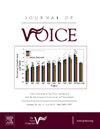声带褶皱振动过程中空气动力和弹性力的流体-结构相互作用分析
IF 2.5
4区 医学
Q1 AUDIOLOGY & SPEECH-LANGUAGE PATHOLOGY
引用次数: 0
摘要
我们利用流动-结构-相互作用(FSI)模型探讨了声门内涡流对声门流动波形的影响。这些涡流是在声带振动的闭合阶段在声带上部附近形成的。声带的几何形状基于著名的 M5 模型。该模型不包括声带,以消除声带对声门流动的惰性影响。声带覆盖层和主体层的材料属性是根据组织弹性的实验数据进行曲线拟合而设定的。我们使用市售的 FSI 求解器对低值和高值的声门下输入压力进行了模拟。对 FSI 结果的验证表明,声门流量和声带位移数据与切除犬喉模型的测量结果非常吻合。模拟结果进一步支持了声门内涡流会影响声门流量波形,特别是其最大流量下降率(MFDR)的假设。模拟结果表明,声门内涡流强度最高和负压最大时,声门流量最大衰减率会出现在同一阶段。研究还表明,当出现最大流量下降率时,作用于声门壁的空气动力大于组织中预测的弹性反冲力。这些发现具有重要意义,因为几乎所有研究声带振动机制的理论和计算模型都没有将声带涡流造成的声门内负压视为作用在声带褶皱上的额外闭合力。本文章由计算机程序翻译,如有差异,请以英文原文为准。
Fluid-Structure Interaction Analysis of Aerodynamic and Elasticity Forces During Vocal Fold Vibration
The effect of the intraglottal vortices on the glottal flow waveform was explored using flow-structure-interaction (FSI) modeling. These vortices form near the superior aspect of the vocal folds during the closing phase of the folds’ vibration. The geometry of the vocal fold was based on the well-known M5 model. The model did not include a vocal tract to remove its inertance effect on the glottal flow. Material properties for the cover and body layers of the folds were set using curve fit to experimental data of tissue elasticity. A commercially available FSI solver was used to perform simulations at low and high values of subglottal input pressure. Validation of the FSI results showed a good agreement for the glottal flow and the vocal fold displacement data with measurements taken in the excised canine larynx model. The simulations result further support the hypothesis that intraglottal vortices can affect the glottal flow waveform, specifically its maximum flow declination rate (MFDR). It showed that MFDR occurs at the same phase when the highest intraglottal vortical strength and the negative pressure occur. It also showed that when MFDR occurs, the magnitude of the aerodynamic force acting on the glottal wall is greater than the elastic recoil force predicted in the tissue. These findings are significant because nearly all theoretical and computational models that study the vocal fold vibrations mechanism do not consider the intraglottal negative pressure caused by the vortices as an additional closing force acting on the folds.
求助全文
通过发布文献求助,成功后即可免费获取论文全文。
去求助
来源期刊

Journal of Voice
医学-耳鼻喉科学
CiteScore
4.00
自引率
13.60%
发文量
395
审稿时长
59 days
期刊介绍:
The Journal of Voice is widely regarded as the world''s premiere journal for voice medicine and research. This peer-reviewed publication is listed in Index Medicus and is indexed by the Institute for Scientific Information. The journal contains articles written by experts throughout the world on all topics in voice sciences, voice medicine and surgery, and speech-language pathologists'' management of voice-related problems. The journal includes clinical articles, clinical research, and laboratory research. Members of the Foundation receive the journal as a benefit of membership.
 求助内容:
求助内容: 应助结果提醒方式:
应助结果提醒方式:


